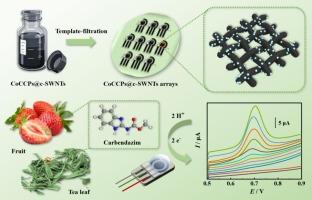Scalable one-step fabrication of integrated electrode arrays for highly sensitive and portable carbendazim detection
IF 8.5
1区 农林科学
Q1 CHEMISTRY, APPLIED
引用次数: 0
Abstract
Highly sensitive and portable pesticide residues detection are indispensable for safeguarding food safety and environmental health. Herein, we introduce a one-step vacuum filtration strategy for the scalable production of cobalt-based conjugated coordination polymers (CoCCPs) electrode arrays, utilizing carboxylated single-walled carbon nanotubes (c-SWNTs) as bonding bridges (CoCCPs@c-SWNTs). Due to their abundant active sites and high conductivity, the CoCCPs@c-SWNTs arrays exhibit superior electrochemical performance (e.g., active area, charge transfer capacity, adsorbed charge, etc.) and enhanced electrocatalytic activity for carbendazim (CBZ). Benefiting from the homogeneous and twining interface, the CoCCPs@c-SWNTs arrays also demonstrate good repeatability, reproducibility, and stability (relative standard deviations <5 %). The CoCCPs@c-SWNTs sensor, with a linear range of 0.01–4.0 μM and a detection limit of 1.9 nM, has been successfully employed in tea and strawberry samples. Overall, this novel sensor holds great potential for application in rapid on-site detection of pesticide residues.


用于高灵敏度和便携式多菌灵检测的集成电极阵列的可扩展一步制造
高灵敏度、便携的农药残留检测是保障食品安全和环境健康不可或缺的手段。在此,我们介绍了一种一步真空过滤策略,用于可扩展生产钴基共轭配位聚合物(CoCCPs)电极阵列,利用羧化单壁碳纳米管(c-SWNTs)作为键合桥(CoCCPs@c-SWNTs)。由于其丰富的活性位点和高导电性,CoCCPs@c-SWNTs阵列具有优异的电化学性能(如活性面积、电荷转移能力、吸附电荷等),并增强了对多菌灵(CBZ)的电催化活性。得益于均匀和缠绕界面,CoCCPs@c-SWNTs阵列也表现出良好的重复性、再现性和稳定性(相对标准偏差<;5 %)。该CoCCPs@c-SWNTs传感器线性范围为0.01 ~ 4.0 μM,检出限为1.9 nM,已成功应用于茶叶和草莓样品中。总之,这种新型传感器在农药残留快速现场检测中具有很大的应用潜力。
本文章由计算机程序翻译,如有差异,请以英文原文为准。
求助全文
约1分钟内获得全文
求助全文
来源期刊

Food Chemistry
工程技术-食品科技
CiteScore
16.30
自引率
10.20%
发文量
3130
审稿时长
122 days
期刊介绍:
Food Chemistry publishes original research papers dealing with the advancement of the chemistry and biochemistry of foods or the analytical methods/ approach used. All papers should focus on the novelty of the research carried out.
 求助内容:
求助内容: 应助结果提醒方式:
应助结果提醒方式:


